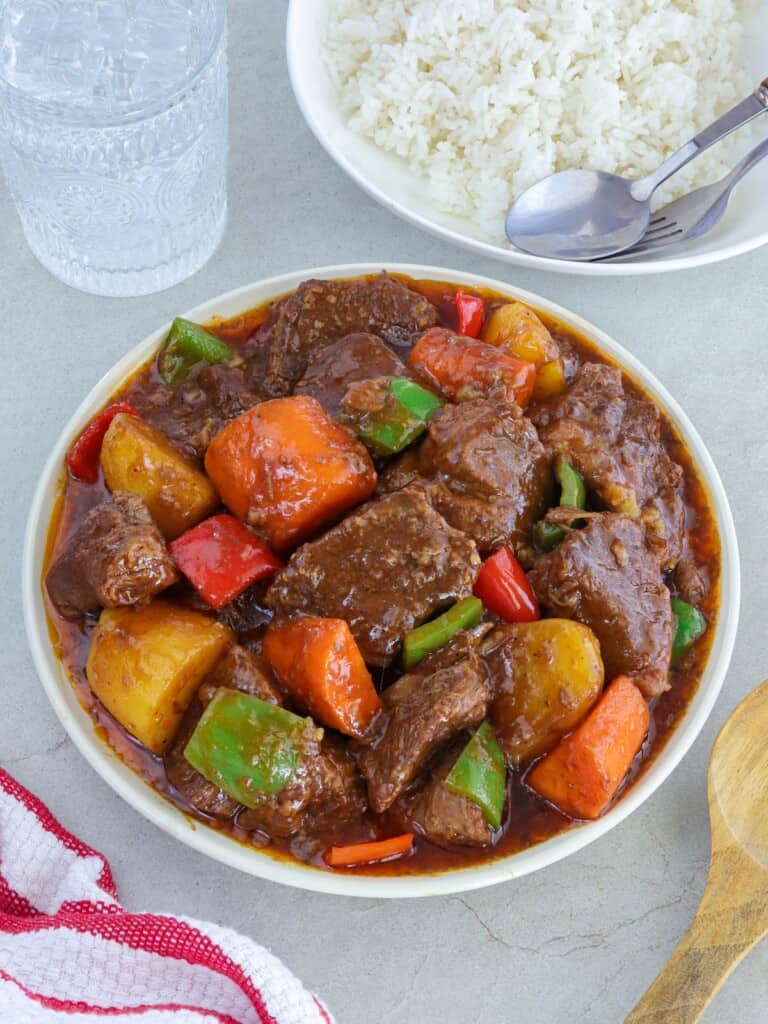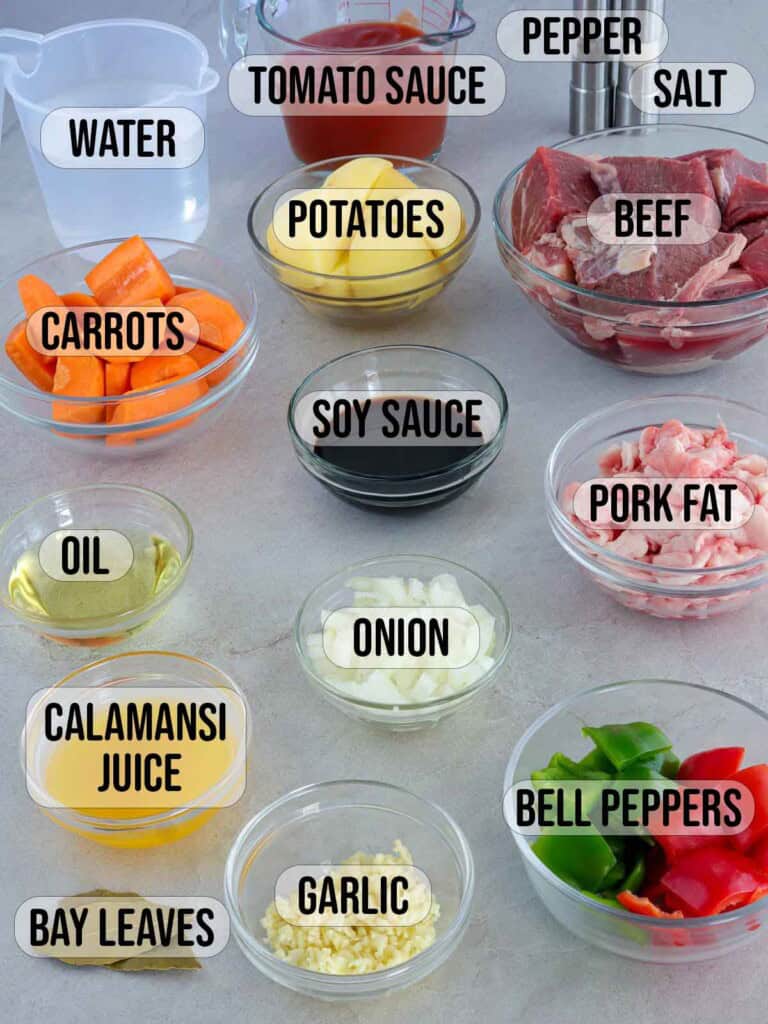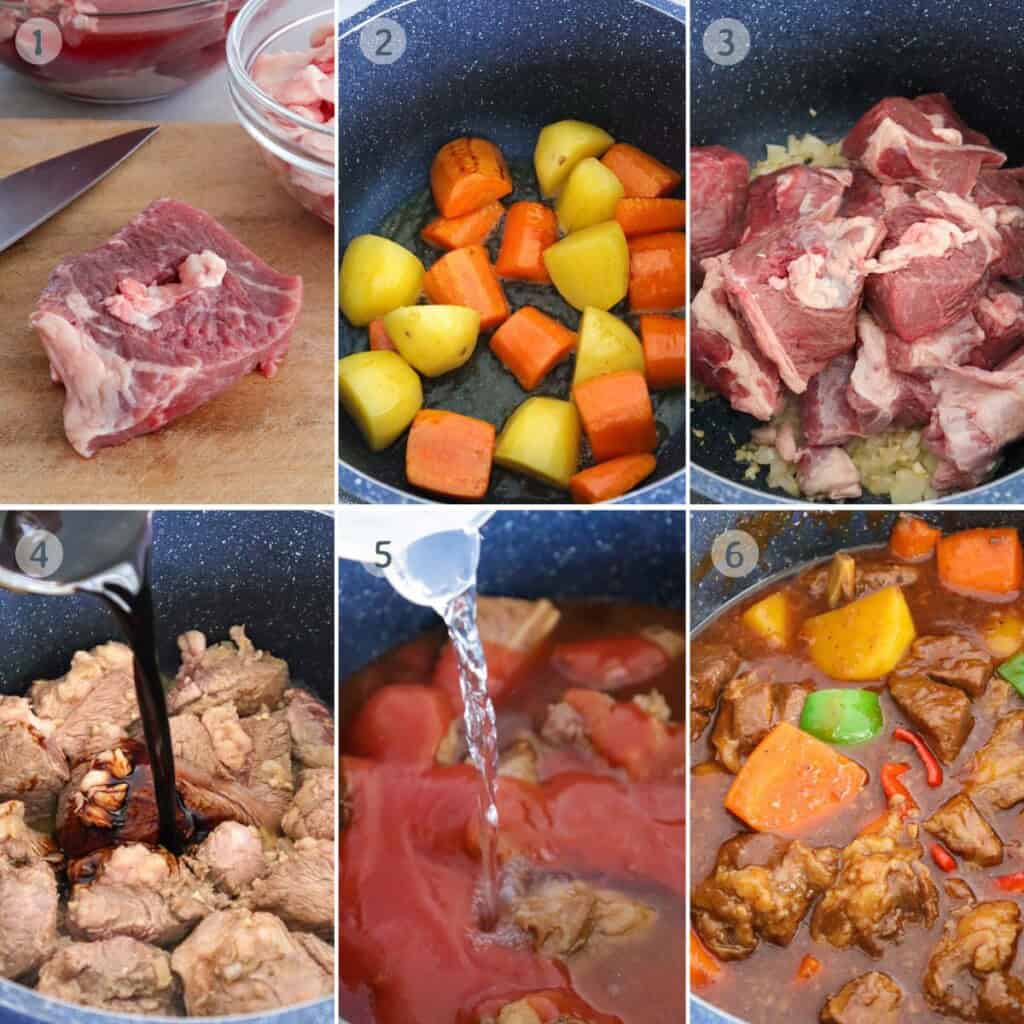Beef Mechado is a Filipino-style beef stew made of larded beef chunks braised in tomato sauce with potatoes and carrots. It’s a delicious and filling dish that pairs well with steamed rice.

The presence of marbling usually determines the quality of the beef. The more marbling it contains, the better the cut. The intramuscular fat visible as white specks embedded within the muscle fibers helps the meat retain its juiciness and tenderness.
As we all know from our pork adobo and crispy pata, the fattier parts are the tastiest. In beef mechado, this culinary fact is applied via an ingenious technique of inserting “wicks” of pork fat called lardons or lardoons into cheaper, leaner beef cuts. The threaded fat strips melt as the larded beef pieces cook, adding flavor and tenderness.
What Mechado means
Mechado comes from the Spanish root word Mecha, which means “wick.” Influenced by Spanish colonization, this Filipino stew traditionally uses the cooking practice of larding inexpensive meat cuts with strips of pork back fat.
However, it has been adapted to suit local tastes. Calamansi juice and soy sauce, along with aromatics such as garlic, onions, and bay leaves, are key ingredients in the braising liquid, which provides a depth of flavor. Chunks of carrots, potatoes, and bell peppers complete the dish with added color and texture.
The term mitsado has evolved over the years to include other cuts of meat, such as pork, chicken, beef ribs, and fish stewed in tomatoes. These present-day versions have mostly dispensed the larding process.
Ingredient notes

- Beef– chuck roast, top or bottom round, or brisket are great inexpensive cuts to use
- Pork back fat– skip if you want to trim down the fat and calories
- Potatoes and carrots – these root/tuber crops deliciously extend the dish
- Calamansi or lemon juice– infuses flavor and helps tenderize the meat; about ¼ cup
- Soy sauce– adds umami flavor
- Tomato sauce– substitute chopped fresh tomatoes, if you like, for a fresher taste
- Onions, garlic, and bay leaves– aromatics add depth of flavor
- Bell peppers– use a combination of green and red for a more festive color
- Water– liquid for braising; you can use beef broth for a more intense flavor.
- Salt and pepper– season the dish to taste
Difference between Mechado, Afritada, and Calderata
Onions, garlic, and tomatoes are the holy trinity of Filipino cooking and provide the groundwork for many Filipino dishes such as afritada, kaldereta, and mitsado. But while these classic dishes are similar in their cooking process and use of potatoes, carrots, and bell peppers, adding a few key ingredients gives them their distinct taste.
- Afritada– most popular versions, such as chicken afritada, pork afritada, or beef afritada are stewed in fresh tomatoes or tomato sauce; other recipes may include pineapples for a sweeter taste
- Caldereta– kalderetang baka or kalderetang kambing usually includes olives, liver spread, and chili peppers for a richer flavor and kick of heat; other regional versions also use coconut milk or shredded cheese for a touch of creaminess
- Menudo– traditionally made with bite-sized cut pork, liver, garbanzo beans, raisins, and occasionally hotdogs or Vienna sausages.
- Mechado– braised in tomato sauce, calamansi juice, and soy sauce for a tangy and savory flavor.
Cooking process

- Use a small knife to make a small incision on the meat and insert the pork fat. The beef should be uniform in size to ensure even cooking. Two to three-inch chunks are a good size to fit a strip of fat.
- Pan-fry the potatoes and carrots until lightly browned. This will keep them from falling apart when added to the stew.
- Saute onions and garlic until softened. Brown the beef in hot oil to build flavor. To sear properly, don’t overcrowd the pan and cook in batches as necessary
- Add calamansi juice and soy sauce. While you can marinate the beef in the citrus juice and soy sauce if you like, I find this extra step unnecessary. The beef will cook long enough in the braising liquid to absorb all the flavors.
- Add tomato sauce, water, and bay leaves. Boil, skimming scum that may float on top. Lower heat, cover, and simmer until beef is tender. If drying out before the meat is tender, add water in ½ cup increments.
- Add potatoes and carrots and cook until tender and sauce is slightly reduced. Add bell peppers and cook until tender-crisp. Adjust seasonings with salt to taste.